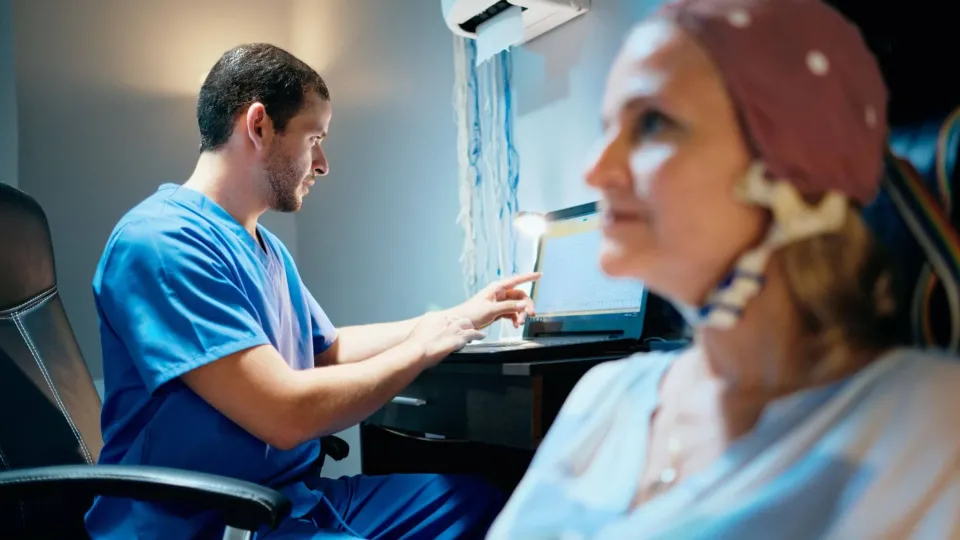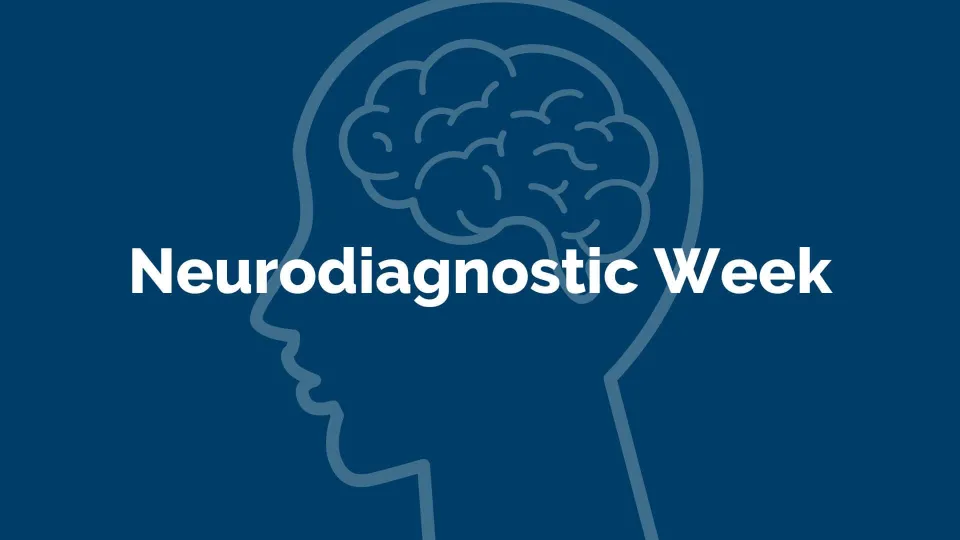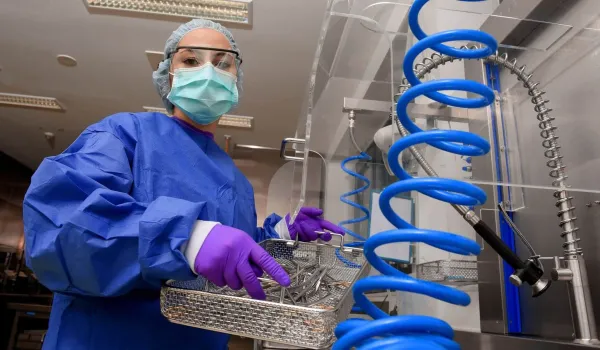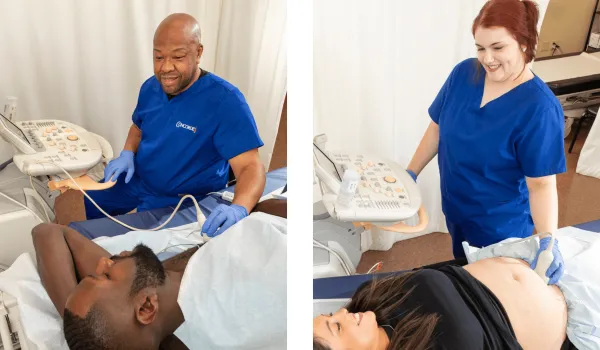
Neurodiagnostic technology programs prepare students to perform tests that help diagnose brain and nervous system disorders. These programs combine classroom coursework with hands-on training to ensure students develop the necessary skills to work in health care settings. Understanding the key coursework and clinical training in neurodiagnostic technology may help those considering this career determine if it's the right fit.
What Is a Neurodiagnostic Technologist?
A neurodiagnostic technologist studies the electrical activity in the brain and nervous system. They have the skills and knowledge to record electrical activity relating to a patient's nervous system function and may work in various health care settings, including hospitals, emergency departments, clinics, research centers, intensive care units, and patients' homes.
The position is transitional, so these professionals can earn additional certifications with continuing education and increased experience. Most employers prefer students to have an associate degree or higher or to have completed a certification accredited by the Commission on Accreditation of Allied Health Education Programs. Students should meet the competencies specified by the Neurodiagnostic Society's National Competency Skill Standards. Neurodiagnostic technologists collaborate with medical researchers, clinicians, doctors, and other health care professionals.
Core Coursework
Neurodiagnostic technology programs include foundational courses that provide students with the knowledge they need for the field. Most programs cover the following core subjects, though the curriculum may vary depending on the institution:
- Anatomy and physiology: A focus on neuroanatomy and neurophysiology helps students understand the brain and nervous system.
- Medical terminology and patient care: These courses ensure that students can communicate well and provide safe, high-quality care.
- Neurodiagnostic procedures: Students learn about electroencephalograms, evoked potentials, polysomnography, and nerve conduction studies.
- Neurodiagnostic equipment: Students should understand the technical aspects of neurodiagnostic equipment, such as electronics, instrumentation, and recording techniques.
- Research methods and ethics: Some programs include coursework on scientific research and ethical considerations in health care.
Most programs prepare students for certification exams, which are not mandatory but likely required for employment. Prerequisites typically include a high school diploma, being at least 18 years old, and providing official academic transcripts. International students may need to have their credentials evaluated.
Hands-On Training
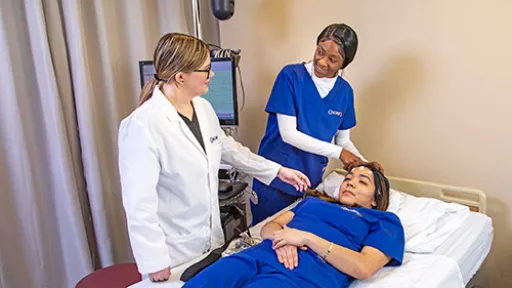
Training in the field is an important part of neurodiagnostic technology programs, as it helps students apply classroom knowledge in clinical settings after graduation. Hands-on training at a pre-approved clinical site includes laboratory sessions during which students practice using neurodiagnostic equipment, electrode placement, and recording techniques. Supervised clinical rotations or internships allow students to work with real patients.
Hands-on training covers various procedures, such as EEG, EP, PSG, and NCS, and students gain experience with patient interaction and effective communication. They also learn safety protocols and equipment troubleshooting to address technical challenges. Clinical experience varies depending on the course but typically involves two days per week (16 hours/week total) with weekday hours from 7 a.m. to 6 p.m. Students might travel up to two and a half hours to reach their assigned clinical sites.
Related: Training Opportunities To Become an EEG Technician
Program Length and Structure
Neurodiagnostic technology programs typically last one to two years, depending on whether they lead to a certificate or an associate degree. Concorde Career College's Neurodiagnostic Technologist program helps students earn an associate degree in as few as 17 months.
Concorde's Neurodiagnostic Technologist program offers a mix of classroom instruction and hands-on clinical experience. Its in-person programs are available at select Concorde campuses. Aspiring neurodiagnostic technologists should check with their local campus for program availability, and there are also online and hybrid options. These programs often include 15 neurodiagnostic technology courses, totaling 30 credits. The program length and structure can vary between institutions, so students should carefully review the details of any program they're considering.
Specialized Areas of Study
Advanced neurodiagnostic technology programs may offer specialized courses that focus on specific areas, such as:
- Intraoperative neuromonitoring
- Pediatric and neonatal neurodiagnostics
- Advanced sleep studies and PSG
- Neuroimaging techniques
- Long-term epilepsy monitoring
- EEG and EP
- NCS and other studies
Specializing in one of these areas can open up additional career opportunities due to an aging population and an increasing prevalence of neurological disorders.
How To Prepare for Certification
Neurodiagnostic technology programs prepare students for their professional certification exams. The two main certifying bodies are the American Association of Electrodiagnostic Technologists and the American Board of Registration of Electroencephalographic and Evoked Potential Technologists.
Many programs align their curriculum with the certification requirements of organizations such as ABRET. Training may include practice tests or cover specific areas for exam prep. Students typically learn about the various certification options available in the field. Programs may also offer guidance on the most relevant certifications for a student's preferred career path. Some programs may include the certification exam fee in their tuition.
Certification Options for Neurodiagnostic Technologists
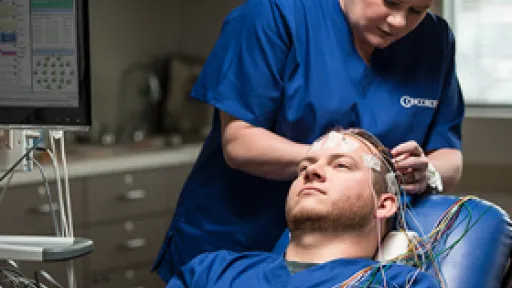
While certification in the field is not legally required, it is highly recommended. Many employers may prefer or require new hires to be certified. Certification demonstrates that professionals have a standardized level of knowledge and competence in the field. The AAET offers the Registered Nerve Conduction Study Technologist certification, while ABRET has six certifications in varying competencies:
- Registered Neurodiagnostic Technologist
- Certified Polysomnographic Technician
- Certification in Intraoperative Neuromonitoring
- Registered Evoked Potential Technologist
- Certification for Long Term Monitoring
- Certified Autonomic Professional
The American Board of Electrodiagnostic Medicine requires students to have at least 12 months of full-time, hands-on NCS clinical training. This training should be supervised by a neurologist or physiatrist experienced in electrodiagnostic medicine, preferably an ABEM Diplomate (a board-certified physician). In addition, students must have interacted with at least 250 patients undergoing NCSs.
Alternatively, students can complete a CAAHEP-accredited Electroneurodiagnostic /Neurodiagnostic Technologist program. Concorde offers a CAAHEP-accredited program that can be completed in as few as 17 months. Students must also have participated in 100 patient interactions supervised by a neurologist or physiatrist experienced in EDX medicine, preferably an ABEM Diplomate. Concorde's educational program also includes hands-on training and off-site clinical experience.
To keep their certification, professionals must complete at least 15 hours of education in neurodiagnostic technology each year, covering all modalities the technologist performs.
Making an Informed Decision
Neurodiagnostic technology programs provide a well-rounded education combining theoretical knowledge and hands-on clinical experience. Students have the opportunity to gain the skills necessary for success with coursework covering neuroanatomy, diagnostic procedures, patient care, and certification preparation. Researching different programs and their specific offerings can help you find the right path to achieving your goals. Get started by contacting a Concorde admissions representative.
Related: Day in the Life of a Neurodiagnostic Technologist
Frequently Asked Questions
Here are some frequently asked questions about pursuing a career in neurodiagnostic technology.
What are the primary neurodiagnostic procedures a typical program covers?
Most programs cover EEG, EP, NCS, IONM, and PSG.
What specific equipment do students learn to use during hands-on training sessions?
Students train with EEG machines, EMG and NCS equipment, sleep study devices, and IONM systems.
What are the current certification options available for neurodiagnostic technologists?
The R. EEG T. from ABRET is the main certification. Other options include R. EP T., CNIM, and Registered Polysomnographic Technologist for specialized areas.
How do neurodiagnostic technology programs incorporate emerging technologies into their curriculum?
Programs may integrate artificial intelligence-assisted EEG interpretation, wearable neurodiagnostic devices, and advanced neuromonitoring techniques to gather real-time data.
What are the prerequisites for enrolling in a neurodiagnostic technology program?
Most programs require a high school diploma or a General Education Development certificate. Some providers may ask for math, biology, anatomy, and physiology coursework.
How do neurodiagnostic technology programs prepare students for patient interaction and bedside manner?
Programs include communication skills training, ethical considerations, and hands-on patient care practice.
What are the most common challenges students face in neurodiagnostic technology programs?
Challenges include mastering technical skills, understanding complex neurophysiology concepts, and balancing coursework with clinical hours.
How do neurodiagnostic technology programs address continuing education and staying updated with industry advancements?
Most programs encourage ongoing continuing education units through professional organizations such as ASET and ABRET. Students typically need to complete at least 15 hours of continuing education each year to keep their certification.
29-2099.01 - Neurodiagnostic Technologists. (2025). Onetonline.org. https://www.onetonline.org/link/details/29-2099.01
Exploring the Role and Career Path of Neurodiagnostic Technologists | Neuro Pathway. (2024). Myneuropathway.com. https://www.myneuropathway.com/blog/exploring-the-role-and-career-path-of-neurodiagnostic-technologists
López, J., Ahn-Ewing, J., Emerson, R., Ford, C., Gale, C., Gertsch, J. H., Hewitt, L., Husain, A. M., Kelly, L., Kincaid, J. C., Kise, M., Kornegay, A., Moreira, J. J., Nuwer, M. R., Schneider, A., Stecker, M. M., Sullivan, L., J. Richard Toleikis, Wall, L., & Herman, S. T. (2023). Guidelines for Qualifications of Neurodiagnostic Personnel: A Joint Position Statement of the American Clinical Neurophysiology Society, the American Association of Neuromuscular & Electrodiagnostic Medicine, the American Society of Neurophysiological Monitoring, and ASET—The Neurodiagnostic Society. Journal of Clinical Neurophysiology, 40(4), 271–285. https://doi.org/10.1097/wnp.0000000000001004
National Competency Skill Standards - ASET - The Neurodiagnostic Society. (2025, January 29). ASET - the Neurodiagnostic Society. https://www.aset.org/national-competency-skill-standards/
Certification Requirements. (2025). AANEM. https://www.aanem.org/abem/home/technologist-certification/initial-certification/certification-requirements
Take The Next Step Towards a Brighter Future
Interested in learning more about our Neurodiagnostic Technology program?
We have a Concorde representative ready to talk about what matters most to you. Get answers about start dates, curriculum, financial aid, scholarships and more!

